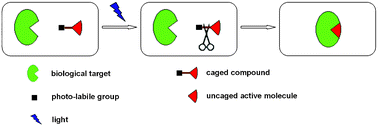Chemistry and biological applications of photo-labile organic molecules
Abstract
Photo-labile molecules have been widely used not only in organic synthesis but also in biological study. The chemistry of the typical photo-labile organic molecules, including their structure, mechanism underlying their photo-lability and strategies to integrate them with biomolecules, is reviewed to illustrate the structural basis for photo-activable caged compounds. Biological applications of representative photo-labile caged molecules were also illustrated for a general understanding on the important roles of caged compounds in dynamic biological studies. This tutorial review would provide an interdisciplinary overview on the important area of chemical biological study making use of photo-labile caged compounds.


 Please wait while we load your content...
Please wait while we load your content...